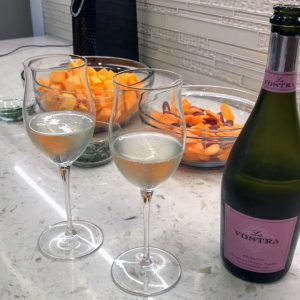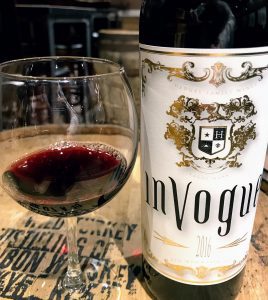
Here is what I’m reading today in the world of wine.
Isabelle Legeron MW: why it matters what wine we drink and food we eat by Alistair Morrell for The Buyer (@TheBuyer11)
I recently finished reading Clark Smith’s Postmodern Winemaking: Rethinking the Modern Science of an Ancient Craft where he advocates for a balance between winemakers using all the tools at their disposal (like reverse osmosis, cross-flow filtration, etc) but not lose sight of “soulful winemaking” and letting the wine tell the story of where it came from. It’s almost a contradictory position that is the vino-equivalent of the Kobayashi Maru.
Throughout the entire book, Smith advocates for, above all, more transparency in winemaking. A winemaker shouldn’t use any tool or additive that he or she would not feel comfortable openly talking about. In that regard, he and Master of Wine Isabelle Legeron would be kindred spirits.
In her interview with Alistair Morrell, Legeron draws the connection between consumers’ concerns over sourcing and knowing what’s exactly in their food and how that is changing the wine they are drinking. However, as I discovered in researching for my article about Vegan wines, the wine industry has a bit of a halo effect that has long been given a free pass in most consumers’ minds because—it’s just grapes, right? Well….not exactly.
Like Smith, I don’t think winemakers should be demonized for using technology but I also find sympathy with Legeron’s view that consumers should know what kind of chemicals are being used in the vineyards, what additives like Mega-Purple or oak chips do and what in the world was done to make a wine like Apothic Brew exist.
The article also touches on some of the issues that “natural producers” dealt with in the troublesome vintage 2017 which brings me to my next article of interest.

Ch. Rauzan-Ségla in Margaux
The 2017 Bordeaux Barrels Diary: A View from the Top at Château Canon by James Molesworth (@JMolesworth1) for Wine Spectator (@WineSpectator)
As the 2018 en primeur tastings wrap up, we’re getting ready for the start of the 2017 Bordeaux Futures campaign. I’m buckling down into my research as I plot my own personal strategy and purchases. I bought very heavily in the 2015 and 2016 campaigns so I naturally expect to buy much less in 2017.
But I’ll still buy something. My initial instinct is that 2017 could serve as a fair “cellar defender” vintage meant to be open for more short term consumption. I use the term “cellar defender” because my cellar will now have a nice stash of 2015/2016 that I will need to fight off the temptation to open too soon–a fate that has unfortunately befallen many of my 2009/2010 gems. If I want to get the full value of my pleasure investment in these potentially great 2015/2016 wine, I will need to have a few good “sacrificial lambs” to help keep my grubby paws off the good stuff.
The key will be in sorting through the hype and fluff to find the real value. I don’t want to pay filet mignon prices for my mutton.
The Chanel Group’s holding of Ch. Canon, Ch. Rauzan-Ségla and now Ch. Berliquet intrigue me because the first two have undoubtedly been on the upswing and reaping the benefit of investments in the vineyards and winery. Rauzan-Ségla has particularly impressed me with delivering quality results in the troublesome 2012 and 2013 vintages. While I would not want to go into the $100+ range, if the 2017 is priced in the $75-80 range like those 2012/2013s then I might be intrigued.
However, having the Chanel team now at Ch. Berliquet (which is priced in the $35-40 range) could be some very enticing mutton
Making Varietal Wines in Bordeaux by Vicki Denig (@vicki_denig) for Seven Fifty Daily (@SevenFiftyDaily). Brought to my dash via John Corcoran (@jncorcoran1).
Going along with my Bordeaux mood, I got very excited reading about this new project with Michael H. Kennedy II of Component Wine Company in Napa (a protege of Aldo Sohm) and Château Lynch-Bages to come up with a special series of varietal wines from some of the Cazes family’s holdings in the Left Bank.
While blending is always going to be intimately connected with Bordeaux, the chance to try the individual components in isolation (from such a high quality producer) is worth geeking out over. Of course it will depend on if the price is crazy or not. While I expect to pay $100+ for Ch. Lynch-Bages, I’m not sure a varietal Cabernet Franc from them at that price is going to entice me. My optimistic hope is that these Component wines will be priced more in the $35-45 range.
I signed up for Component Wine Company’s mailing list to keep an eye on this project and will post any updates.
What’s On Deck for SpitBucket
In addition to getting knee deep in readings about the 2017 Bordeaux vintage and Futures campaign, I’m also prepping for my upcoming trip to Paso Robles for Hospice du Rhone at the end of this month and a trip to Burgundy at the end of May. So expect to see a few more posts geeking out about Rhone varietals and a couple more installments in my “Keeping up with the Joneses in Burgundy” series.

My top wine at the 2017 Wine Spectator Grand Tasting was this Adobe Road Cabernet Sauvignon from the Beckstoffer Vineyard Georges III in Rutherford.
In the middle, I’ll also be attending the Wine Spectator Grand Tour Tasting in Las Vegas. You can check out the first part of my three part series from last year’s Grand Tour Tasting here.
While my blog postings won’t be as frequent during my travels, I will still be posting regularly to Instagram and Twitter so feel free to follow me on those platforms as well.
Cheers!


